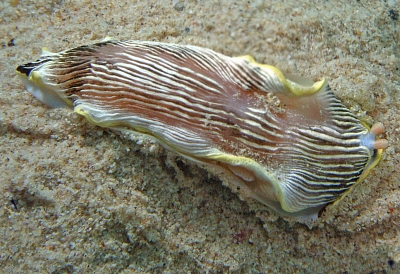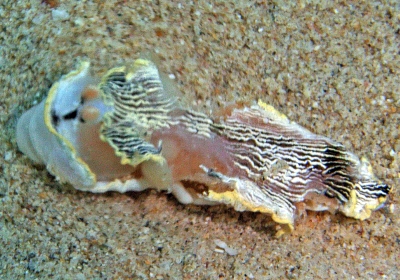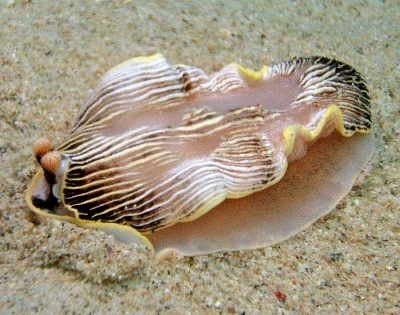Re: Armina wattla (?) from Bonaire
November 24, 2006
From: Marge Lawson


Concerning message #18388:
Thank you for the information, which is greatly appreciated.
Shortly after posting the message I found the third Armina again. The first time I saw it, only the tail was visible and it was soon completely under the sand. I spent several hours in that area searching for it during the next few days, and finally found the tip of the tail sticking out of the sand. I watched it for about 1 ½ hours, and during that time it came completely out of the sand three times, moved a little, then after a couple of minutes dug back down under the sand.
I'm wondering if the "bald spots" might be something common to this species. I've attached some more pictures to explain why I think this.
The first Armina had stripes at the head and tail and along the outside edges, but was smooth and pink in the very middle (see picture on previous posting #18388 ). The second Armina had two bald spots with stripes in between the bald spots and stripes all the way down the sides. The spots were fairly symmetrical, although the picture doesn't clearly show it since the edge toward the bottom of the picture is curled up and partially obscures the bald spot on that side. The third Armina was similar to the second Armina in that some of the stripes went all the way down the back (on the sides and middle), but had bald spots to each side of the middle. The bald spots were much longer than on the second Armina.
It seems like if they were bite marks, they wouldn't be so symmetrical. I'm also attaching a very poor quality picture of the second Armina after I found it dead on the sand. It has obvious bite marks on it, but they are on the edges, not the back.
I realize it is very difficult to determine the nature of the bald spots, especially from pictures, but thought I'd share that information with you.
It does seem odd that I've found three Arminas recently, all during the daytime. Either I'm extremely lucky, or maybe they are fairly common on our reef, and I've just been lucky to see some of them on the occasions when they've come out from under the sand for a short while.
Locality: Bari Reef, 10 to 15 foot depth, Bonaire, Netherlands Antilles, Caribbean, October and November 2006, sandy bottom. Length: 1 to 1 1/4 inches. Photographer: Marge Lawson.
Marge Lawson
margebonaire@yahoo.com
Lawson, M.I., 2006 (Nov 24) Re: Armina wattla (?) from Bonaire. [Message in] Sea Slug Forum. Australian Museum, Sydney. Available from http://www.seaslugforum.net/find/18566
Dear Marge,
Thanks for the extra photos. I can't be 100% sure but my only explanation is that something has taken bites out of these animals. My interpretation of the pink marks is that they are not colour marks but deep wounds where all the normal black and white ridging has been removed.
If the predator is larger than the Armina then symmetry in the markings is evidence in favour of teeth bites, as teeth are arranged symmetrically. If a fish predator was to bite down the length of the animal I would expect to find such markings. As I said in my earlier comments, I suspect the reason you have found these three animals on the surface is because they are badly injured and apparently unable to do their normal behaviour and burrow in the sand during daylight hours. I must say your middle photo made me feel quite sorry for the nudibranchs.
Best wishes,
Bill Rudman
Related messages
-
Smiling Armina from Bonaire
From: Ellen Muller, July 18, 2008 -
Re: Armina wattla (?) from Bonaire
From: Marge Lawson, November 20, 2006 -
Armina wattla (?) from Bonaire
From: Les Wilk, January 26, 2006 -
Armina wattla? from the Caribbean
From: Dave Elliott, September 28, 2002
